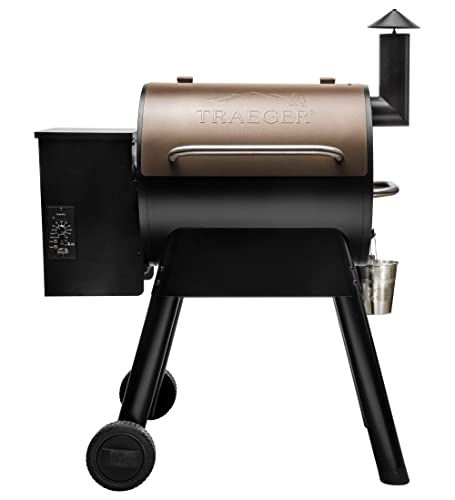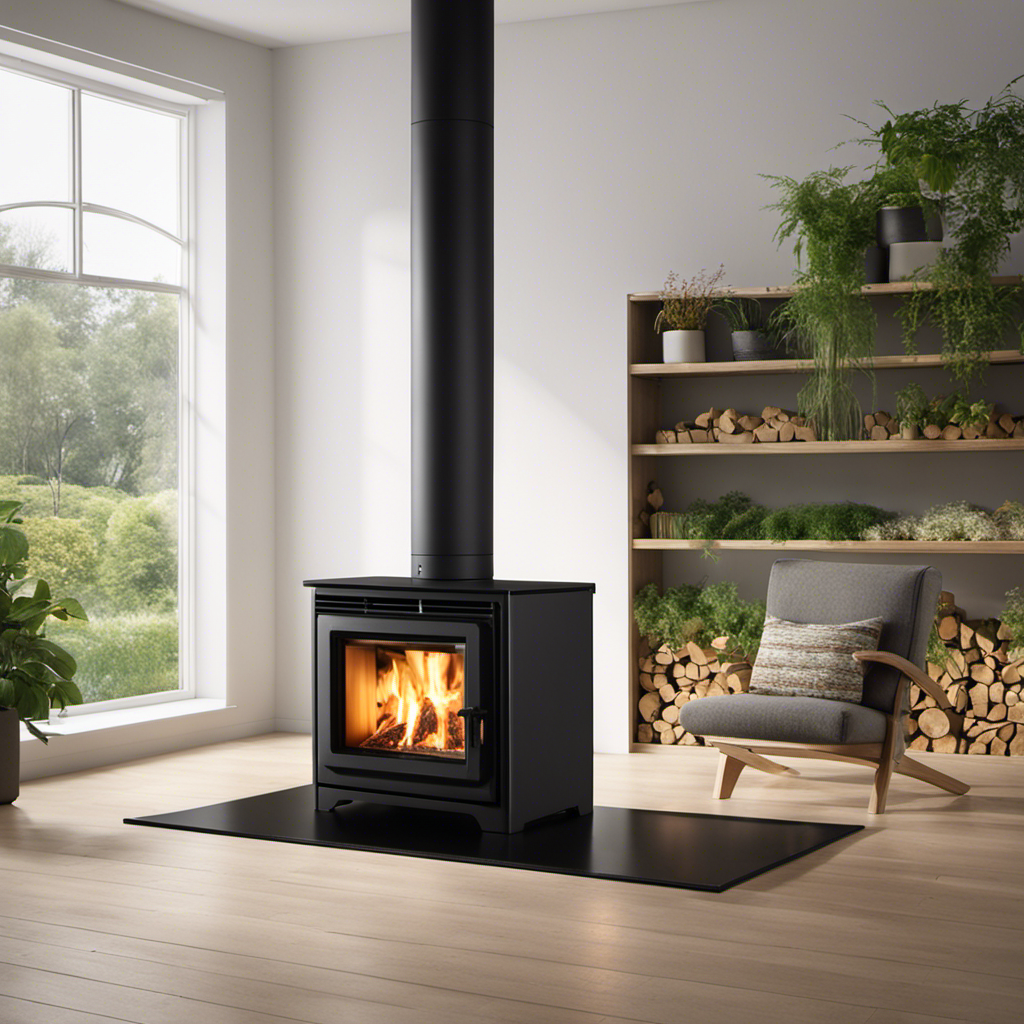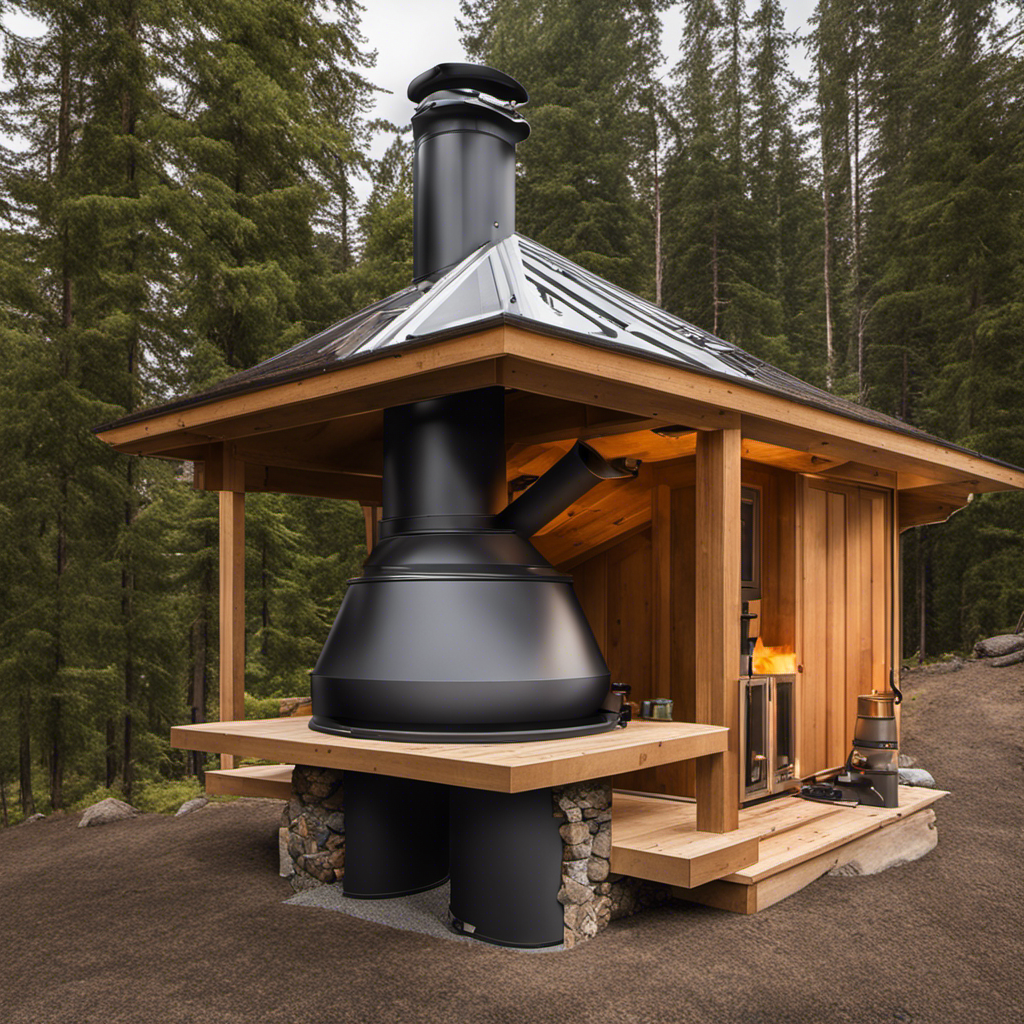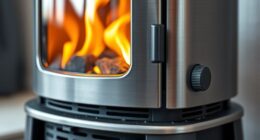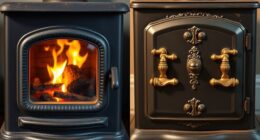Positioned before the intensely blazing stove, surrounded by its warmth, I catch myself wondering: is it powered by wood or pellets? The difference between them rests in the minute details that distinguish one from the other.
By examining the fuel source, the exterior appearance, and the combustion process, we can uncover the truth. Additionally, checking for a hopper and ash pan, and consulting the manufacturer or an expert, will provide further confirmation.
Join me on this journey of discovery as we unravel the mystery of your stove’s true nature.
Key Takeaways
- Wood stoves primarily burn wood as fuel, while pellet stoves use compressed sawdust or organic materials as fuel.
- Pellet stoves are highly efficient, provide consistent heat output, and have a lower environmental impact compared to wood stoves.
- Wood stoves have a traditional chimney design with a vertical pipe, while pellet stoves often have a smaller, streamlined chimney design with a horizontal vent pipe.
- Pellet stoves have an automated fuel delivery system and controlled burning process, while wood stoves require constant monitoring and refueling.
Differentiating Fuel Sources
One way to differentiate between a wood stove and a pellet stove is by looking at the fuel sources they use.
Wood stoves, as the name suggests, primarily burn wood as their fuel. Wood is a renewable resource and can be easily obtained, making wood stoves a popular choice. However, wood stoves can be less fuel efficient and have a higher environmental impact compared to pellet stoves.
On the other hand, pellet stoves use pellets made from compressed sawdust or other organic materials as their fuel. These pellets are highly efficient and provide a consistent heat output. Additionally, they produce fewer emissions and have a lower environmental impact than wood stoves.
Now, let’s move on to examining the exterior appearance of these stoves to further differentiate them.
Examining Exterior Appearance
Take a close look at the exterior appearance to determine whether it’s a wood or pellet stove. Here are some key factors to consider:
-
Chimney Design:
-
Wood stoves typically have a traditional chimney design with a vertical pipe extending from the top of the stove.
-
Pellet stoves, on the other hand, often have a smaller, more streamlined chimney design with a horizontal vent pipe.
-
Heat Output:
-
Wood stoves tend to produce a higher heat output, making them suitable for larger spaces or colder climates.
-
Pellet stoves have a regulated heat output, which makes them more efficient for smaller spaces or milder climates.
-
Efficiency:
-
Wood stoves are known for their low efficiency, as they require constant monitoring and refueling.
-
Pellet stoves, on the contrary, have a higher efficiency due to their automated fuel delivery system and consistent burn rate.
By examining the exterior appearance and considering factors like chimney design, heat output, and efficiency, you can easily identify whether a stove is wood or pellet.
Moving forward, let’s analyze the combustion process to gain further insight into stove functionality.
Analyzing Combustion Process
Examining the combustion process will provide valuable insight into how the stove functions. Understanding efficiency and comparing emissions are key factors in determining whether a stove is a wood or pellet stove.
When analyzing the combustion process, it is important to consider the type of fuel being used. Wood stoves burn logs or wood pellets, while pellet stoves exclusively burn wood pellets. Wood stoves rely on a traditional combustion process, where logs are burned in a firebox. Pellet stoves, on the other hand, use an automated process that involves feeding wood pellets into a combustion chamber. This process allows for more controlled and efficient burning, resulting in lower emissions.
By understanding the differences in combustion processes between wood and pellet stoves, it becomes easier to identify the type of stove being examined.
Transitioning into the subsequent section about checking for the hopper and ash pan, it is important to examine these components as they provide further clues about the type of stove.
Checking for Hopper and Ash Pan
To determine whether the stove is a wood or pellet stove, you can simply check if it has a hopper and an ash pan. A hopper is a storage container that holds the pellets, while an ash pan collects the ashes for easy disposal.
Here are some steps to help you in checking for temperature control and inspecting the flue pipe:
-
Look for a temperature control panel or knob on the stove. Wood stoves typically don’t have this feature, as the temperature is controlled manually by adjusting the airflow.
-
Check if there is a flue pipe connected to the stove. This pipe is used to vent the exhaust gases out of the house. Pellet stoves usually have a dedicated flue pipe, while wood stoves may have a chimney.
-
Inspect the size and shape of the fuel. Wood stoves burn logs, while pellet stoves use small, compressed wood pellets.
-
Look for an automatic ignition system. Pellet stoves often have this feature, making them easier to start compared to wood stoves, which require manual ignition.
-
Check for any indication on the stove or the user manual that specifies the type of fuel it uses.
By following these steps, you can determine whether your stove is a wood or pellet stove.
However, if you are still unsure or need further guidance, it is always recommended to consult the manufacturer or an expert in stoves and heating appliances. They can provide you with accurate information and guide you in making the right choice for your heating needs.
Consulting Manufacturer or Expert
If you’re still unsure about the type of stove you have, it’s best to consult the manufacturer or an expert for accurate information and guidance. By consulting professionals, you can ensure that you receive reliable advice tailored to your specific stove model. Additionally, researching online can provide valuable insights and resources from stove experts and enthusiasts.
When reaching out to the manufacturer or an expert, make sure to provide them with all the relevant details about your stove, such as its make, model, and any distinguishing features. This information will help them determine whether you have a wood or pellet stove and provide you with the necessary information to operate and maintain it properly.
To give you an idea of the types of information you might find, here is a table comparing some key differences between wood and pellet stoves:
| Wood Stoves | Pellet Stoves |
|---|---|
| Burns firewood | Burns compressed wood pellets |
| Requires manual feeding | Automatic pellet feeding |
| Produces traditional heat | Provides consistent heat |
| Requires chimney or flue | Can be vented through a wall |
What are the key factors to look for in determining if a stove is a wood or pellet stove?
When determining the difference between pellet stoves and wood stoves, there are key factors to consider. Look at the fuel source – wood stoves burn firewood, while pellet stoves use compressed wood or biomass pellets. Check the exhaust vent – pellet stoves typically have a horizontal vent, while wood stoves have a vertical vent.
Frequently Asked Questions
Are There Any Additional Safety Precautions to Consider When Using a Wood or Pellet Stove?
When using a wood or pellet stove, it is crucial to consider safety precautions. These include regular maintenance, such as cleaning the chimney and inspecting the stove for any damage. Additionally, ensure that the fuel is replenished frequently to avoid any potential hazards.
How Often Should the Fuel Be Replenished in a Wood or Pellet Stove?
I find that the fuel replenishment frequency in wood stoves is higher compared to pellet stoves. Wood stoves require more frequent refilling, usually every 4 to 6 hours, while pellet stoves can go up to 24 hours before needing more fuel.
Can a Wood Stove Be Converted to a Pellet Stove, or Vice Versa?
Can a wood stove be converted to a pellet stove, or vice versa? Yes, it is possible to convert a wood stove to a pellet stove or vice versa. However, it is important to consult a professional for a successful conversion.
Are There Any Specific Maintenance Requirements for Wood or Pellet Stoves?
When it comes to wood stove maintenance, regular cleaning of the chimney and ash removal are crucial. For pellet stove maintenance, cleaning the hopper and ash pan, as well as inspecting the auger, are important tasks.
What Are the Average Costs Associated With Operating a Wood or Pellet Stove?
Well, let me break it down for you. When it comes to the average costs of operating a wood or pellet stove, there’s quite a bit to consider. Let’s dive into the comparison, shall we?
Conclusion
In conclusion, determining whether a stove is a wood or pellet stove requires a keen eye and thorough analysis. Just as a skilled detective unravels clues to solve a mystery, we must examine fuel sources, exterior appearance, combustion process, and the presence of a hopper and ash pan.
By employing these investigative techniques, we can confidently identify the stove’s true nature. Remember, like deciphering a complex riddle, understanding the nuances of different stove types takes patience and expertise.




